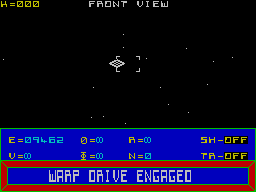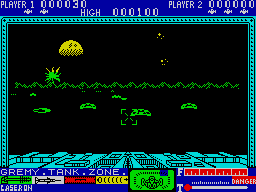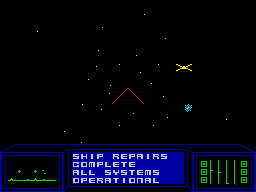
SPACE GAMES
The top five Spectrum arcade adventures, the best of the rest, and a brief history of the genre.

1. ELITE
(Firebird - 1985)
Originally written for the BBC Micro by Ian Bell and David Brabben, Elite is a combination space shooter, strategy and RPG. You are a space trader, travelling between systems, buying and selling goods. You can play it straight by dealing legal merchandise or take your chances with the law by running drugs, slaves and weapons. As you blast and trade your way through the game, you accumulate cash with which to improve your ship, and watch your rating progress from a lowly 'Harmless' to the ultimate accolade, 'Elite'. With its space stations, pirates, special missions and elegiac battles, Elite is one of the greatest games of them all.

2. TAU CETI
(CRL - 1985)
Author Pete Cooke, who'd previously dabbled in adventures and even a skiing simulator, wanted to improve upon the trend of wire-frame graphics by making them solid and adding shading. Tau Ceti is set on the third planet of the titular sun, where man's colonies have been abandoned and the world taken over by a race of advanced robots. Your mission is to shut down the main reactor which powers the defence droids. Your mechanical foe are smart and well-armed, though, and their ships are over you like a rash the moment you leave your planetary base. A large, complex game that captures the best of many different genres.

3. 3D STARSTRIKE
(Realtime - 1984)
When Crash magazine moved into its 'Ludlow Towers' offices, the landlord of a nearby house they rented, a Mr Onions, urged them to take a look at the game his son Andrew had written. It turned out to be a rather good Battlezone clone eventually released as 3D Tank Duel. Onions' next project was 3D Starstrike and, put simply, was the best of the Star Wars copies seen to date. You begin by fighting enemy ships in space, before swooping down towards the 'Deathstar' and destroying its gun emplacements. Finally, you descend into the trench to do battle. Things get a little slow when the screen fills up, but it's still a corker.

4. STARION
(Melbourne House - 1984)
Starion is a fascinating combination of sumptuous space shooter and puzzle game. Intentionally or not, Starion successfully exploited the frenzy surrounding Elite's impending arrival by offering something loosely similar in look and complexity. That said, it is radically different to Braben and Bell's classic, and in many ways more intricate. The plot is admittedly odd (you must pass through more than two hundred different time zones using riddles obtained by fighting enemy spacecraft), but it's a massive game, with some of the best wireframe graphics ever seen on the Spectrum, and it kept players busy long after Elite's release.

5. CODENAME MAT
(Micromega - 1984)
Codename Mat was the most successful early 'Star Trek' type game. As Mat you must defend the solar system against the dreaded Myons. The usual Trekkie features of long and short range scanners are present, and there are some nice strategy elements. The 3D graphics are effective and come into their own during bitter dogfights in defence of mother Earth. Although not as good-looking as Starstrike or Elite, Codename Mat offers a different kind of challenge to either, and deserves its reputation as a seminal space classic. There was a sequel, also written by Crash magazine's Derek Brewster, but it was too similar to the original for most tastes.
Battle of the Planets (Mikrogen - 1986)
I remember playing a demo version of this at the Mikrogen shop in Bracknell and thinking this made me part of the software industry. It's a decent tie-in with the popular cartoon series of the time. Essentially an alien blaster with fast line graphics and enough strategy elements to hold the interest for a while. A departure from Mikrogen's usual output and one that holds a special place in my nostalgic heart.
The Black Planet (Phipps - 1983)
Pirates: scourge of the spaceways. It's your job to wipe out their sorry hides and track down their home, the Black Planet. This treacherous sphere is invisible until you find the sections of 'The Key' scattered across seven planets. On each world a different sub-game must be completed to capture the key segment, and you can expect to come under attack from pirates as you travel between them. Despite looking dated at times, this is a gargantuan game and not one to be taken lightly.
Dark Star (Design Design - 1984)
Having changed name from Crystal, Design Design's first title was this slick space shooter. As commander of 'The Liar', you must visit enemy planets and destroy their defence systems. This involves approaching each planet's central complex and wiping its control towers, while holding your ship inside the floating rectangles of protective shielding. The game was criticised for its lack of depth and undetailed graphics, but this is a back-to-basics shoot 'em up, with glorious wireframe 3D and a huge playing area. It also has a few tricks up its sleeve. Try typing 'everyone's a nervous wreck' into the high score table.
'Space game' might seem like a rather ambiguous description, given that space is the setting for everything from shoot 'em ups to adventures. What we are dealing with here, though, are futuristic games played primarily from the cockpit of a spacecraft. The majority of these titles used the 'starfield' effect - that wall of dots that rushes towards the player, giving the impression of speed and movement. Although astronomically nonsensical, it became a standard and effective device.
The complexity and purpose of space games differ greatly. At one end of the scale there is the pure shoot 'em up, such as Design Design's Dark Star, in which strategy elements are sidelined in favour of whizz-bang arcade action. At the other extreme is the sophisticated Elite, which combined action, adventure and RPG elements to stunning effect. To play this game today is still a joy, and to think that such a vast, absorbing program consisted of just 29K of code is mind-boggling.
Between these two titles, there was a great diversity of imitators, many based around Atari's 1983 arcade smash, Star Wars. In terms of coin-op gaming, this was as close to perfection as any first-person shooter came. Many attempts were made to transfer its dazzling vector graphics to the Spectrum, but only the Starstrike series came close to replicating its combination of electric action and visual finesse.

The best of the rest
3D Lunattack (Hewson - 1984)
The Seiddab ('baddies' spelled backwards) appeared as the villains in a series of games by Andrew Hewson, culminating in this Moon-based shooter. You must guide your hover craft through three rings of defence about the Seiddab base, battling tanks, mines, missiles and enemy fighters. The sound and graphics are top-notch and the game is only let down by its use of cursor keys for control.
Galaxy Attack (Sunshine Books - 1983)
Galaxy Attack is a bit creaky and serves as a reminder of what bounds were made on the Spectrum in just a few years, but it was one of the earliest space games, and has some imaginative touches (despite the author's blatant riffing on the Star Wars films). You start the game in space and battle through waves of enemy fighters, until you crash-land on a remote planet. On the surface, you have to repair your ship and escape before you're destroyed by enemy walkers. Once back in space, you must attack the enemy mothership. Phew!
Starglider (Rainbird - 1986)
Starglider was one of the earliest titles to utilise the enhanced capabilities of the 128K Spectrum, by including digitised speech and additional missions in a souped-up edition. Both versions are triumphs of programming that test the limits of the Spectrum's capabilities. In essence, the game is a cockpit-based tactical shooter, pitting you against waves of enemy Stargliders, but the sublime graphics and novel features (such as missile-view and action replays) mark this out as a benchmark title that may have been equalled but was never surpassed on the Spectrum.
Starstrike II (Realtime - 1986)
A terrific sequel to the original Starstrike. You battle your way through twenty-two different planets in your quest to destroy the evil Outsiders. This involves several waves of combat: entering an enemy space station, duelling with fighters and racing through a ventilation duct, cannons blazing. The graphics are an improvement over the original and the Spectrum copes better with the strain of the 3D images than it did with its predecessor. Nowadays, dedicated graphics cards do all the heavy lifting, so it's a testament to the ingenuity and skill of the programmer that such stunning visuals were handled by a 3.5 MHz processor and a few kilobytes of RAM.

Timegate (Quicksilva - 1983)
Earth has been invaded by the Swarm, a hostile race of aliens. Using a number of timegates, you must guide your ship through history and destroy their HQ, battling enemy ships all the way. You are provided with a 3D view from your cockpit and a long range scanner with which to locate the enemy. Alien planets can be landed on to repair battle damage and refuel. The graphics are simple by later standards, but it's eminently playable and drummed up considerable interest at the time thanks to Quicksilva's fabulous cover artwork, effective advertising and enticing inlay blurb. A good quality space adventure from label co-founder John Hollis, and the first Spectrum game to use a 3D space field effect. The system-intensive sound effects revealed a flaw in early Spectrums that caused them to crash, leading some people to buy the game to 'stress test' their computers.